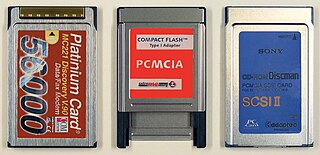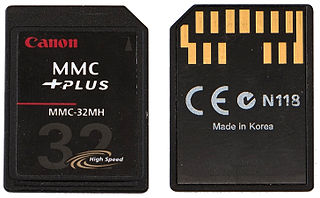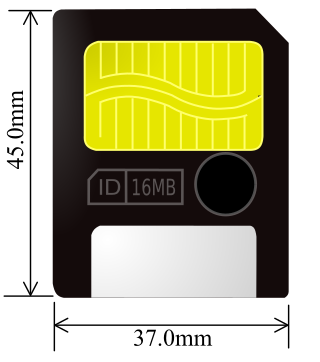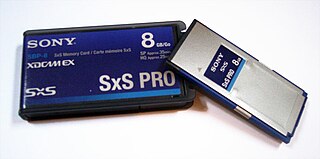Common information
- Unless otherwise indicated, all images are to scale.
| Card family | Standards organizations | Varieties | Entry date | Maximum commercially available capacity | Picture [1] | Main features |
|---|---|---|---|---|---|---|
| CompactFlash | SanDisk | I | 1994 | 512 GB (CF5 128*250 bytes) |  | Thinner (3.3 mm), flash only, now up to 512 GB, although standard goes up to 128 PB since CF 5.0 [2] |
| II | Thicker (5.0 mm), older flash, but usually Microdrives, up to 128 PiB [2] | |||||
| CFexpress | CompactFlash Association | 1.0 | 2017 | 1 TB |  | CFexpress Type B: XQD form factor (38.5 mm × 29.8 mm × 3.8 mm), PCIe 3.0 x2 (1.97 GB/s), NVMe |
| 2.0 | 2019 | ? | CFexpress Type A: 20 mm × 28 mm × 2.8 mm, PCIe 3.0 x1 (1.0 GB/s), NVMe[ citation needed ] CFexpress Type C: 54 mm × 74 mm × 4.8 mm, PCIe 3.0 x4 (4.0 GB/s), NVMe[ citation needed ] | |||
| – | – | – | – | PCIe 3.0 x8 (8.0 GB/s), NVMe | ||
| MultiMediaCard | Siemens AG, SanDisk | MMC | 1997 | 16 GB |  | Slim and small (24 mm × 32 mm × 1.4 mm), up to 16 GB |
| RS-MMC/MMC Mobile | 2003/2005 | 16 GB |  | Compact (24 mm × 18 mm × 1.4 mm), up to 16 GB | ||
| MMCplus | 2005 | 16 GB |  | Compact (24 mm × 32 mm × 1.4 mm), swifter, optional DRM, up to 16 GB | ||
| MMCmicro | 2005 | 4 GB | | Subcompact (14 mm × 12 mm × 1.1 mm), optional DRM, 16 MB to 4 GB | ||
| Nano Memory | proprietary (from Huawei) | 2018 | 512 GB [3] | Subcompact (12.3 mm × 8.8 mm × 0.7) smallest dimensions as of 2024. Can use Nano-SIM slots. | ||
| Secure Digital | SanDisk, Panasonic, Toshiba, Kodak, SD Association | SD | 1999 | 2 GB [4] |  | Small (32 mm × 24 mm × 2.1 mm), DRM, up to 2 GB. [4] (2 GB cards use larger block sizes and may not be compatible with some host devices. See Article) |
| miniSD | 2003 | 2 GB [4] |  | Compact (15 mm × 11 mm × 1 mm), DRM, up to 2 GB. [4] (2 GB cards use larger block sizes and may not be compatible with some host devices. See Article) | ||
| microSD | 2005 | 2 GB [4] | | Subcompact (15 mm × 11 mm × 1 mm), DRM, up to 2 GB. [4] (2 GB cards use larger block sizes and may not be compatible with some host devices. See Article) | ||
| SDHC | 2006 | 32 GB [4] |  | Same build as SD but greater capacity and transfer speed, 4 GB to 32 GB (not compatible with older host devices). | ||
| miniSDHC | 2008 | 32 GB [4] |  | Same build as miniSD but greater capacity and transfer speed, 4 GB to 32 GB. 8 GB is largest in early-2011 (not compatible with older host devices). | ||
| microSDHC | 2007 | 32 GB [4] | | Same build as microSD but greater capacity and transfer speed, 4 GB to 32 GB. [5] (not compatible with older host devices) | ||
| SDXC | 2009 | 1 TB |  | Same build as SD/SDHC, but greater capacity and transfer speed, 32 GB and higher. Standard goes up to 2 TB (not compatible with older host devices). | ||
| microSDXC | 2009 | 2 TB [6] |  | Same build as microSD/microSDHC, but greater capacity and transfer speed, 32 GB and higher. Standard goes up to 2 TB (not compatible with older host devices). | ||
| SDUC | 2018 | not yet available |  | Same build as SD/SDHC/SDXC, but greater capacity and transfer speed. Standard goes up to 128 TB (not compatible with older host devices). | ||
| SmartMedia | Toshiba | 3.3/5 V | 1995 | 128 MB |  | Very slim (45.0 mm × 37.0 mm × 0.76 mm), no wear leveling controller, up to 128 MB. This particular example shows the write protect sticker (the silver disc). |
| Memory Stick | Sony, SanDisk | Standard | 1998 | 128 MB |  | Slim and narrow (50 mm × 21.5 mm × 2.8 mm), optional DRM, up to 128 MB |
| PRO | 2003 | 4 GB |  (not to scale) | Slim and narrow (50 mm × 21.5 mm × 2.8 mm), swifter, optional DRM, up to 4 GB | ||
| Duo | 2003 | 128 MB |  | Compact (31 mm × 20 mm × 1.6 mm), optional DRM, up to 128 MB | ||
| PRO Duo | 2002–2006 | 32 GB |  | Compact (31 mm × 20 mm × 1.6 mm), optional DRM, up to 32 GB | ||
| PRO-HG Duo | 2007–2008 | 32 GB |  | Compact (31 mm × 20 mm × 1.6 mm), swifter, optional DRM, up to 32 GB | ||
| Micro (M2) | 2006 | 16 GB | | Subcompact (15 mm × 12.5 mm × 1.2 mm), optional DRM, up to 16 GB | ||
| Sony | PS Vita Memory Card | 2012 | 64 GB | | Subcompact (15 mm × 12.5 mm × 1.6 mm [7] ), compulsory DRM, up to 64 GB, proprietary (can be used on PS Vita only) | |
| P2 (storage media) | Panasonic | MicroP2 | 2012 | 64 GB | MicroP2 is a SDXC/SDHC card conforming to UHS-II (Ultra High Speed bus), and can be read by common SDHC/SDXC card readers. | |
| xD | Olympus, Fujifilm, Sony | Standard | 2002–2007 | 512 MB |  | Slim and small (20 mm × 25 mm × 1.78 mm), electrically identical to SmartMedia, no wear-leveling controller, up to 512 MB [8] |
| Type M | 2005 | 2 GB |  | Slim and small (20 mm × 25 mm × 1.78 mm) but slower read/write, no wear-leveling controller, up to 2 GB [8] | ||
| Type H | 2005 | 2 GB |  | Slim and small (20 mm × 25 mm × 1.78 mm) and swifter, no wear-leveling controller, up to 2 GB [8] | ||
| XQD card | Sony & Nikon | Standard | 2011–2012 | >2 TB |  | High-capacity, high-speed standard using PCIe as interface |
| Universal Flash Storage Card Extensions | Samsung | UFS Card | 2016 | >256 GB | Packages the flash memory, currently soldered in shipping smartphones, into a removable card form factor. Uses the SCSI command set including queuing. The electrical interface makes use of differential signaling, which enables high bus speeds and robustness under noisy conditions and reduced pin count (compared to parallel bus alternatives such as UHS-I). | |
| USB flash drive | Various | USB 1.1/2.0/3.0/3.1 | 2000/2001 | 1 TB+ | (not to scale) | Universally compatible across most non-mobile computer platforms, their greater size suits them better to file transfer/storage instead of use in portable devices |




















